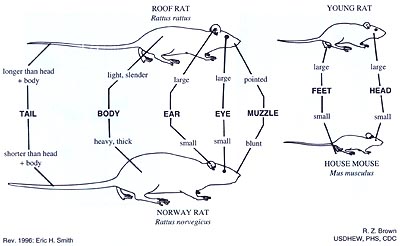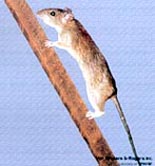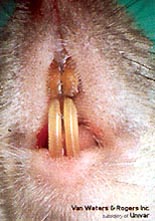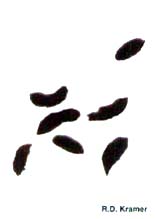Rats
· Various species are problematic in the U.S., mainly the Norway rat and roof rat. · Bite more than 45,000 people each year, according to the U.S. Centers for Disease Control.
· Can burrow three feet straight into the ground, chew through building materials such as glass, cinderblock, wire, aluminum and lead, and can climb inside pipes with diameters between one-half and four inches. · Primarily rely on smell, taste, touch and hearing. · Eat and urinate on human and animal food. · Support many ectoparasites.
Mice
· A female house mouse gives birth to a litter of approximately six mice about 19 days after mating and is capable of mating again in two days. · Can produce six to 10 litters a year. · Are able to mate two months after birth. · Can produce 2,500 heirs in six months, with ideal conditions and no mortality. · Establish a nesting site near sources of food and feed 15 to 20 times a day
SIGNS OF INFESTATION
1. Gnaw marks. New gnawings or holes tend to be rough whereas, old gnawings are smooth from wear. 2. Droppings. Fresh droppings are soft and moist whereas, old droppings are dried and hard; adult roof's about 1/2" (12-13 mm) with pointed ends vs. Norway's about 3/4" (18-20 mm) with blunt ends. 3. Tracks/footprints. Front foot 4-toed and print is in front of usually longer hind print with 5 toes. Fresh tracks are clear and sharp 4. Rub marks or dark, greasy markings on vertical surfaces. Fresh marks are soft, greasy, and easily smeared whereas, old marks are with the grease dry and flaky. Swing marks often present around rafters. 5. Burrows. Not common, but if present they are shallow. They usually nest in or under vegetation. 6. Runways. Travel routes may not be apparent outside because they may travel along fences or on overhead power or telephone lines. Indoors, they usually move along walls, stacked merchandise, etc. Active runways with greasy appearance, free of dust and cobwebs, with fresh tracks and/or droppings. 7. Damaged goods. Roof rats prefer fruits, vegetables, and cereal whereas, Norway rats prefer meat fish and cereal.BIOLOGY.Roof rats reach sexual maturity in 2-5 months. Pregnancy lasts an average of 22 days. The young are blind and naked at birth, with hair appearing in about 7 days and eyes opening in 12-14 days. They are weaned at about 3-4 weeks. The average number of litters is 4-6 per year, each containing an average of 6-8 young. Adults on an average live 9-12 months. They have rather poor vision and are color blind, but their senses of hearing, smell, touch, and taste are keenly developed. Touch is via their vibrissae or long whiskers. They are good runners, excellent climbers and jumpers, and if forced, rather good swimmers. A roof rat requires 1/2-1 oz (14-28 g) of food and 1 oz (30 ml) of water each day, with the water often coming from its food. This results in about 30-180 droppings and 1/2 oz/3 teaspoons (16 cc) of urine per day. Historically, bubonic plague has been associated with the roof rat and its fleas, which move from infested rats to man. Fortunately, plague has not been found in rats in the United States for many years. Other transmitted disease organisms include murine typhus via fleas (also probably via droppings and urine), infectious jaundice/leptospirosis/Weil's Disease via urine in water or food, rat-bite fever via bites, trichinosis via undercooked pork, and food poisoning or Salmonellosis via droppings. Another problem is tropical rat mite dermatitis which is caused by these mites when they feed on humans. HABITS. Roof rats are primarily nocturnal in habit and they are very cautious. Although they constantly explore their surroundings, they shy away from new objects and changes. Roof rats prefer to nest in the upper parts of structures but may be found under buildings as well as occasionally in basements and sewers. Outdoors, they prefer to nest in higher places such as in trees but may occasionally be found in burrows in or under vegetation around the structure. These are social animals but less so than Norway rats. Several nests may be located within a given area. An opening of greater than 1/2" (12 mm) is required for entry into buildings. Although they will eat practically anything, roof rats prefer fruits, vegetables, and cereals. If the eaten food material proves disagreeable, they are quick to develop food/bait shyness. Once they find an acceptable/preferred food, rats tend to eat their fill at one sitting/place and will return time after time. Once established indoors, roof rats tend to follow the same route or pathway between their harborage and food and/or water sources. Runways along vertical surfaces will usually include dark rub or swing marks on the vertical surface where their fur makes contact. Their runways will be free of debris, and outdoors, the grass will be worn away to the bare soil. CONTROL. The key to any rat control program is pest identification, sanitation, harborage elimination, and rat-proofing the building. Control is based on the behavioral habits of the roof rat. Some of the more important things to remember are: 1. Rats defecate where they spend most of their time. Use rat droppings as an indication of where to concentrate the control efforts. Nontoxic tracking powder can also be used to determine where they are most numerous. 2. Rats will travel 100-150 ft (30.5-45.7 m) for food and/or water along established runways. Look for rub/swing marks and clean runways. Place traps or bait stations along runways and against vertical surfaces. Glue boards wired to traveled pipes, rafters, etc. are effective. 3. Rats are gluttons. Place sufficient bait in each bait station for at least 1 meal (stop-feed baits), 2 meals (acute/single-feed baits), or more (chronic/multi-feed baits). Once a preferred bait is found, they utilize this bait until feeding stops. 4. Rats are cautious. Minimal disturbance is desirable when putting out traps and/or bait stations. Pretrapping with unset snap traps or prebaiting with nontoxic bait may be necessary. 5. Roof rats prefer fruits, vegetables, and cereals. Use such high-carbohydrate baits and bait the center of glue boards and snap traps with such foodstuffs. 6. Rats usually have a water source other than their food if their food has a low moisture content. Liquid baits are particularly effective when their normal water source can be reduced or eliminated. 7. Roof rats sometimes nest in ground burrows. Outdoors, gassing (fumigating) rat burrows is extremely effective. Follow label directions and do not gas burrows within 15 ft (4.6 m) of, or burrows which may run under or open into an occupied structure.









